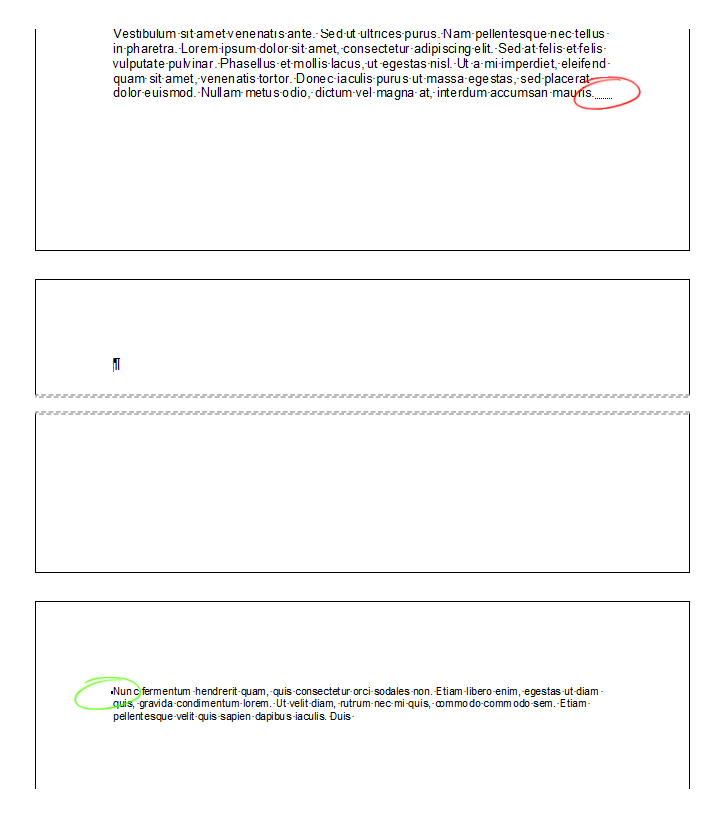Removing Empty Pages in TX Text Control with JavaScript
TX Text Control offers a C# solution for removing empty pages already. However, implementing this in JavaScript provides more flexibility for web environments. By using JavaScript methods to remove empty pages, you can streamline your documents. They will be free of unwanted page break or section break characters.

Dynamically generated documents may accidentally contain empty pages for a variety of technical reasons. Consistent cleanup is necessary to maintain clean documents.
TX Text Control provides a C# solution for removing empty pages already TX Text Control .NET: Removing Empty Pages. However, implementing this in JavaScript provides more flexibility for web environments. By using JavaScript methods to remove empty pages, you can streamline your documents. They will be free of unwanted page break or section break characters.
Learn More
This article explains why to avoid forced page breaks in document templates and how to create templates that automatically adjust to the content using other word processing features.
Scenario: Forced Page Breaks
Consider the following example where one paragraph contains a forced page break (red circle) and the next paragraph always starts on a new page (green circle) because the Paragraph

JavaScript Solution
The removeEmptyPages function is an asynchronous JavaScript function that manages documents by iterating through each page in reverse order to check if the content length is one, which usually indicates a page break or section break. If a page is empty, it is deleted, and the function proceeds to check the previous page.
This is achieved by recursion, where the processPage function calls itself for the next page until all pages have been processed. Recursion is a technique used to solve a problem by creating a function that calls itself repeatedly until it reaches a base condition.
function removeEmptyPages() {
TXTextControl.pages.getCount(function(count) {
function processPage(index) {
if (index < 0) {
return;
}
TXTextControl.pages.elementAt(index, function(page) {
page.getLength(function(length) {
// Check if the page is empty.
if (length === 1) {
page.getStart(function(start) {
TXTextControl.select(start - 1, length, function() {
TXTextControl.selection.setText('', function() {
// After deleting, continue with the next page
processPage(index - 1);
});
});
});
} else {
processPage(index - 1);
}
});
});
}
// Start processing from the last page
processPage(count - 1);
});
}Conclusion
Removing empty pages from documents is a common requirement when generating documents dynamically. By using JavaScript, you can implement a solution that removes empty pages from documents created with TX Text Control.
Also See
This post references the following in the documentation:
- Javascript: Page
Collection Object - Javascript: Page Object
ASP.NET
Integrate document processing into your applications to create documents such as PDFs and MS Word documents, including client-side document editing, viewing, and electronic signatures.
- Angular
- Blazor
- React
- JavaScript
- ASP.NET MVC, ASP.NET Core, and WebForms
Related Posts
Observe When the Reporting Preview Tab is Active Using MutationObserver
This article shows how to observe when the Reporting Preview tab is active using MutationObserver. The Reporting Preview tab is a feature of the TX Text Control Document Editor that allows you to…
Building an ASP.NET Core Backend Application to Host the Document Editor and…
This article explains how to create an ASP.NET Core backend application to host the Document Editor and Document Viewer. This backend application is required to provide the required functionality…
ASP.NETJavaScriptDocument Editor
Detect Toggle Button Changes Using a MutationObserver
This article shows how to detect changes of toggle buttons in the ribbon of the web editor using a MutationObserver. The state of a toggle button in the ribbon visualizes the state of a certain…
JavaScript Functions for Typical Form Field Tasks
The new JavaScript API not only enables programmatic access to all elements of a document, but also provides events for user interaction.
ASP.NETASP.NET CoreDocument Automation
Why Document Processing Libraries Require a Document Editor
A document processing library alone cannot guarantee reliable and predictable results. Users need a true WYSIWYG document editor to design and adjust templates to appear exactly as they will after…






